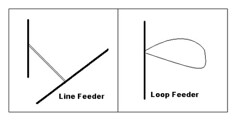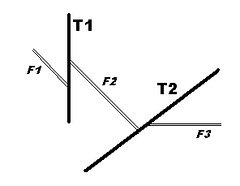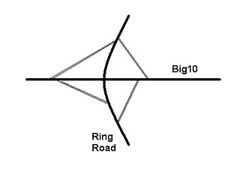During the Big10 meeting with Prof. Ashwin Mahesh, it was suggested that Praja-galu can suggest feeder bus services, which the professor could take up with BMTC.
In this post, I am attempting to come up a set of ideas/guidelines that should help Praja design the feeder bus routes for their neighbourhood. The ideas presented here are not necessarily comprehensive and hence I would like you to provide feedback on these thoughts.
The BMTC has recently introduced the Big10 service and the Kendriya Sarige(KS) service, by identifying the 10 trunk roads that bring the maximum traffic to the CBD and interconnecting them with the KS. The main deterrent for the commuter to use the service is the problem of getting into the main road from his locality. To resolve this problem, the BMTC needs to provide feeder service from a residential locality off a trunk road, hence connecting it to the trunk road at respectable frequencies.
I have tried to categorise the feeder routes into varieties – Line feeder and Loop feeder.
In order to better understand these concepts, please read the below paragraph carefully. Loop feeder is not the same the loop buses that we have seen in the past. Any feeder is intended to connect one point (or a small segment) on a trunk road/route with different areas of a residential/industrial complex. A line feeder will travel away from the trunk road on a particular route and returns back to the trunk road on the same route. It does not necessarily mean that the feeder travels on only one road!! In contrast, a loop feeder will move out of the trunk road in one direction, travels on a closed loop path, and travels back towards the trunk road on a different route.
Terminating points:
Additionally, for both the line and loop feeders, the terminating point(s) need not be trunk road itself; the trunk road may have the first bus stop or the penultimate bus stop and then the feeder terminates beyond the trunk road. While loop feeder can have only one terminating point (starts and terminates at the same bus stop), line feeder can have either one or two terminating points, based on the route distance and timings. If the one-way travel time of a line feeder is about 15-20 mins, then it is convenient for the bus crew to return back to the originating point. If the one way travel time is much higher (40-60 mins), the feeder can have two terminating points.
Utility of the two types of feeder-service:
Many localities have only one trunk service in the vicinity, and hence the area dynamics (traffic pattern, population density in different parts/lanes within the locality, bus commuter density in different parts/lanes within the locality, availability of roads and their capacity to carry a bus) will determine which of the two options is better.
But if a locality has two trunk services in the vicinity (say a Big10 and a ring road service), a line feeder will be more effective; since only one service will be able to connect to both trunk routes. The main plus of a line feeder over a loop feeder is the possibility of merging two adjoining line feeders into a single route.
In the above illustration, by running the feeders F1,F2 and F3 as a single route, we can not only connect the individual localities to the nearest trunk route, but also connect them to other nearby trunk routes. This sort of a integration can be particularly useful if the two trunk routes are perpendicular (a big10 and ring road service), since perpendicular trunk routes mean different directions of travel.
There can very well be other ‘styles’ of integrating line feeder routes.
Circular routes:
Presently, the KS is the circular ‘trunk’ service in the heart of the city and the ring road services are another ‘trunk’ routes towards the periphery of the city. Prof. Ashwin Mahesh, during the discussion on Big10 in IIM, talked about having three more circular routes in the city to supplement the existing trunk routes. The integrated line feeders can be convenient alternative to such circular routes, since the city do not necessarily have roads that can act as these C1, C2 and C3 routes. Ofcourse, some part of such routes could also be possibly through the existing trunk routes.
I would love to get feedback from Praja. I request you to provide further suggestions so as to form a more complete guideline document.








ಪ್ರತಿಕ್ರಿಯೆಗಳು
Mapping it to a real example!
Srivatsava,
Very good and informative post. Is it possible to extend this to a real example? I would really like to see how this will translate into when these are applied to the BIG-10 route and connect this trunk route with some locality.
A real examples..
having stayed in the southern part of Bangalore, so I will try to provide examples from this half of the city. I have a propsal for Avalahalli/Girinagar areas (here) and am looking at possible cases for integration - a hosakerehalli feeder, Veerabhadranagar feeder, Ittamadu feeder etc.
The first example in the post with trunks T1& T2 and feeders F1,F2 & F3 was based on a a few Bangalore north locatilities. Though, I do not have the specific routes, you would understand if I say that T1 and T2 are Bellary road(big10) and Ring road on hebbal. F1 refers to RT nagar feeder, F2 refers to a Bellary Road to Ring Road (or Bhoopasandra) via Sanjaynagar, and F3 could possibly connect Tatanagar(Kodigehalli) to the Ring Road.
In such an integrated feeder, since most people in RT nagar would possibly want to get to Bellary Road(than the Ring road near hebbal), this 'route' will still function as optimally as a 'dedicated' feeder. Additionally, for a fewer number who may travel to the Hebbal Ring Road, this may not be the best possible route, but will relieve them of possibly 1-2 transfers.
Additionally, there could be a scenario where a feeder service is needed to a 'high frequency/capacity feeder service'. For example, there is a monorail planned connecting Katriguppe to National college as a high frequency/capacity feeder service. My proposal for Girinagar/Avalahalli feeder will then feed all the passengers in this locality to that monorail !! And that we the diamond (rhombus) route can be a useful 'high capacity feeder'.
-Srivatsava V
-Srivatsava V
Spot On !
Srivatsava,
Good effort - the idea is to connect as much of the hinterland as possible to a maximum no. of trunk routes, without long travel distances, minimum transit times & with as few routes as possible !
Each of the above described - Line, Loop or Circular can fulfill these requirements for different areas.
Area wise, one might have to consider some non-bus use roads to complete the route & if so, careful evaluation would be required to check if this is possible. Quiet, residential areas are not conducive to this. A street with some commercial activity is best suited, if available.
An aspect not touched upon is the utility of smaller buses, such as the Swaraj Mazdas or the Tata Starbuses for these services. Since route lengths are likely to be small, these Mini-buses could be of great help, operating economically, providing more frequent services & manoevering better on streets within the hinterland.
Another suggestion is to combine two adjacent feeder routes to one during off-peak hours since loads will be low, & since optimum frequency will still have to be maintained.
Finally, ticketing & ticket pricing - combined ticketing would of course be the ideal choice, but BMTC will have to work on this as developing such facilities will involve logistics.
Maybe we could share all this with BMTC at a future meeting !!
No ticketing issues!!
Naveen,
We can take this up with BMTC, but I am confident that BMTC will not 'percieve' any ticketing issues in it. From your comment, I understand 'combined ticket' as one that is issued together for both the feeder and the trunk route it connects to. BMTC will argue (based on my interaction with a few conductors), and I greatly agree with them, that the daily pass is intended specifically for such cases. You may want to argue that the daily pass is too costly at Rs30/-. But, if you want to take a trunk route you are possibly travelling a long distance and you will be prepared to shell out Rs5 for a feeder and Rs10-15 for the trunk route. If you return by bus, which BMTC argues that most bus users do, you will have to shell out more than Rs30 per day and hence the daily pass makes sense.
Further, the commuter can best decide if a daily pass can be beneficial for him!!
-Srivatsava V
-Srivatsava V
Road Classification should determine the bus service
Last evening, when I had gone to drop off my aunt at Anjaneya layout near Ittamadu, I witnessed that when two cars in opposite directions have to cross eachother, it results in a huge pile up of vehicles. You can imagine the effect if a large bus has to go through. Same is the case in the narrow lanes of NR colony, which takes the buses to tyagarajanagar. If two cars cross each other on those lanes (the only roads on earth where footpaths are as 'wide' as the road!!), they have got to be the toys used by 5 year olds!!
I was then reminded of a comment from SB ( http://bangalore.praja.in/discuss/forums/2009/03/kr-circle-be-signal-free#comment-12830), which provoked my thought process a lot. I am using the gist/spirit of the post to come up with this guideline.
We need to classify our roads based on the traffic patterns, length and width of the road etc.
Based on such a classification, we can have different types of bus services ply on these set of roads. For example, on the arterial roads, Big 10 concept is appropriate (even if 10 may not be sufficient). Similarly, the hub and spoke model, that we cant seem to get over, can be used to connect to the Link roads. The small locality roads should not be connected to the hubs like Majestic and market directly. Instead, only feeder services should ply on them, and these should be only on the mini-buses like Swaraj Mazda.
-Srivatsava V
-Srivatsava V
Srivatsava avare' Can't
Srivatsava avare'
Can't agree with you more. But, if left to BMTC, you can write it all off. My experience is elaborated at
http://bangalore.praja.in/blog/naveen/2009/03/21/meeting-with-profashwin-mahesh#comment-12436
In this connection, do also take a look at
http://bangalore.praja.in/blog/murali772/2008/12/20/bangalore-traffic-problems-solutions#comment-10460
Muralidhar Rao
Combined Ticketing Easier With Single Operator
Srivatsava,
The day pass is useful for those when total cost for using multiple buses in a day with individually purchased tickets exceeds the cost of the pass.
Common or combined ticketing is to avoid purchase of tickets on the second or subsequent bus/es during a single journey, thereby saving time & money for the commuter & also simplifying the ticketing process for the operator. The cost may be much lesser than a day ticket.
For services provided by a single operator such as BMTC, combined or common ticketing (ie. a single ticket for two or more trips that involve changing of buses) is easily possible as there will be no revenue splits.
In NewYork, the MTA is a body like BMLTA, & common ticketing is issued for subways (metro) & buses. Thus, revenue is split between the two by MTA & this involves some complications that are overcome by use of IT. Likewise, in Hongkong & many other cities too, they have e-cards that can be used for bus as well as metro & revenues are shared whilst commuters are also benefited.
BMTC can easily have common ticketing if & when feeder services become operational for the Big-10s. However, if this is to be done for bus & Metro, it will involve revenue sharing & will be somewhat complicated since there will be two operators, though both are within the public domain.
Srivatsava, I think you said
Srivatsava,
I think you said it right, we need more feeder buses which could be small size and which can connect to the main roads.
I live in a interior area which is around 3 kms from Bellary road. Its a pain to get to the main road. Once on th emain road, I can get to any part of Bangalore.
Hence If there was a feeder bus that takes a loop and covers couple of adjoining areas then it would have been nice.
Nice post
Wow, I had missed reading this one.
Like Tarle stated on another thread, local shuttles are pretty important and relevant to Bangalore.
First step though would be to identify the "feeding points" on trunk routes. with feeder system in place, trunk route services could be speeded up by having them stop only at important stops - or these "feeding points". Sort of like and express train.
And in this model, the feeder routes will overlap for a bit on the trunk routes, to do the dual job of pulling people from sorrounding areas, as well as from the points on trunk routes that are far from the "feeding points".
Ashwin Mahesh had described one idea of feeder routes (we used a term "local loop shuttles") shaped like "P" or "Q", just make your loop feeder connect two radial trunk routes (say Banerghatta Road and Kanakpura Road). And since the point where you will turn away from BG or KP road may not be where your starting big bus stop would be (say Jayadeva Flyover), you will have to extend the run on BG road to and from the Jaydeva flyover. that will give you a "P".
Connecting two trunk routes via feeder services would be nice because then one single route could transport people to two different directions, so good load factor in both directions of the route.